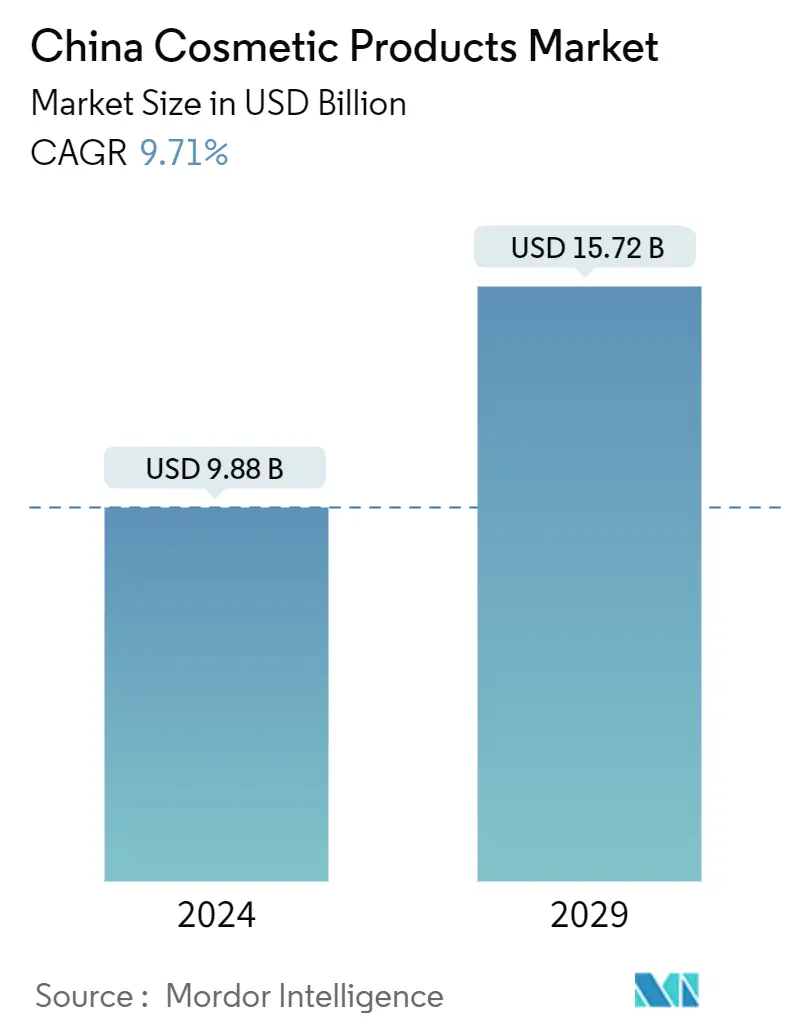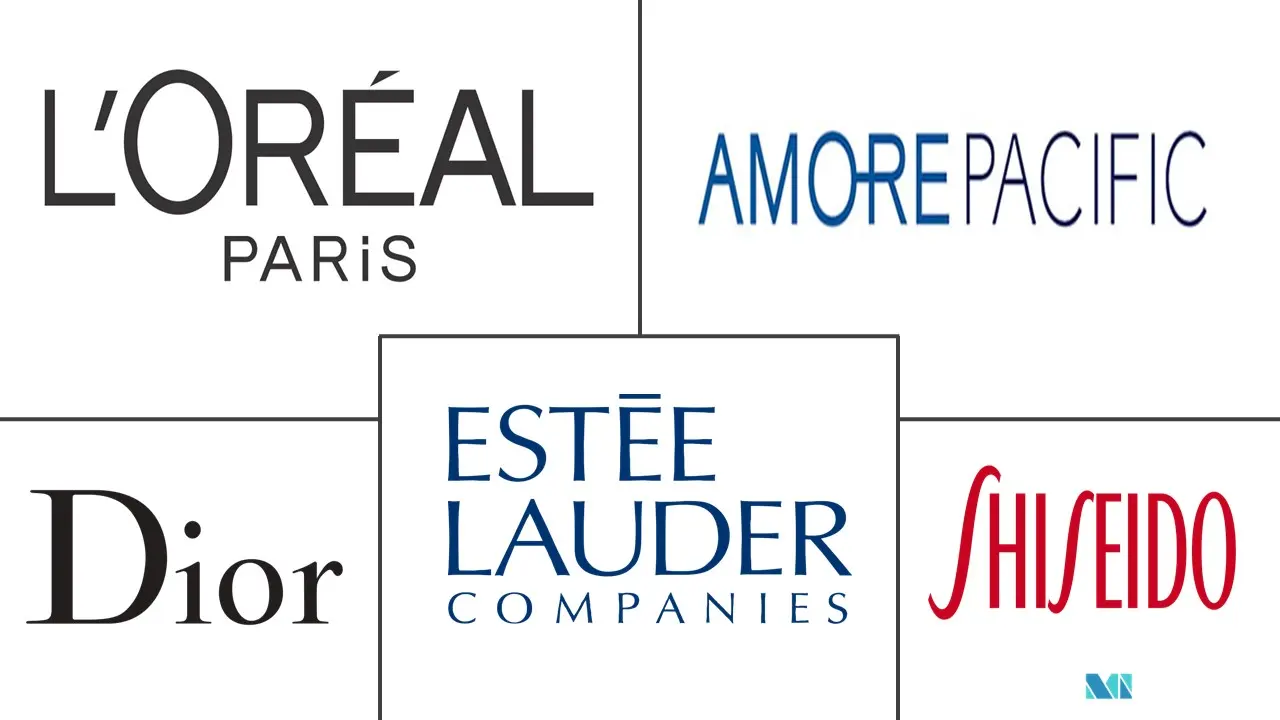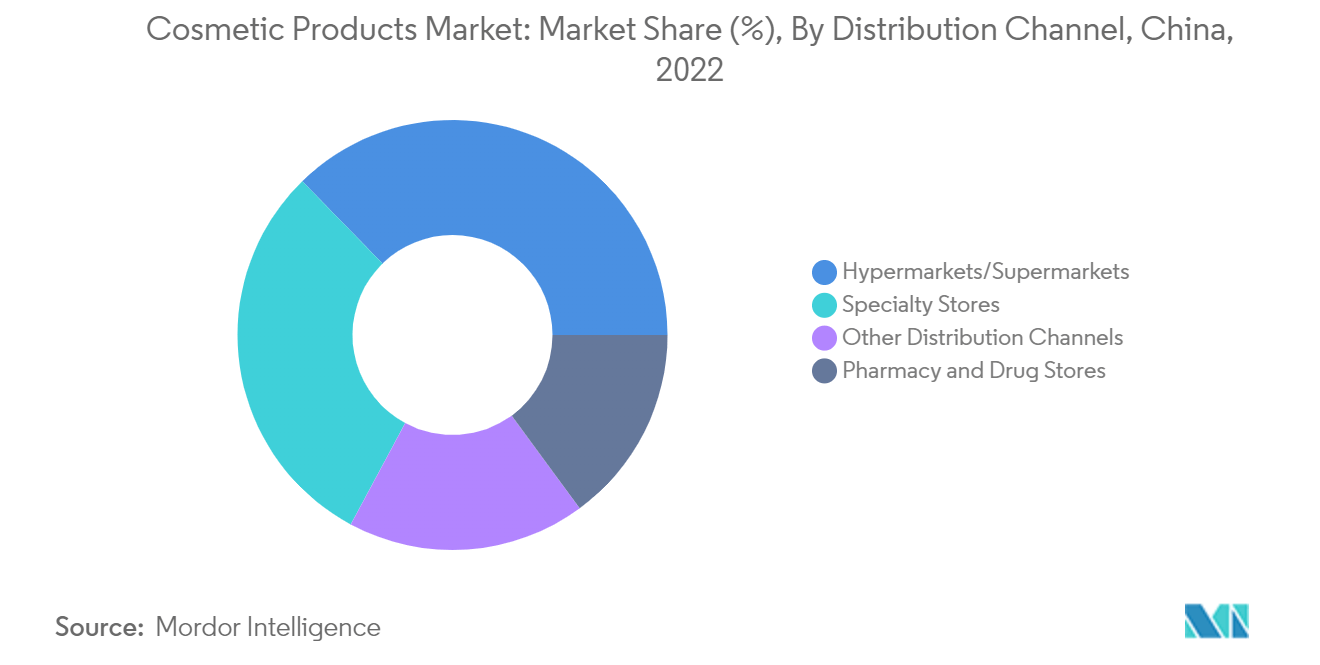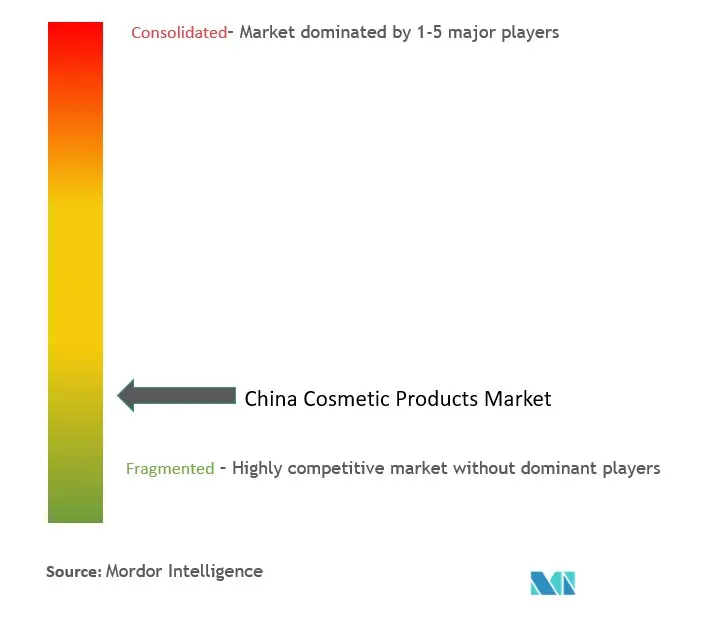China Cosmetics Products Market Size

| Study Period | 2019 - 2029 |
| Base Year For Estimation | 2023 |
| Market Size (2024) | USD 9.88 Billion |
| Market Size (2029) | USD 15.72 Billion |
| CAGR (2024 - 2029) | 9.71 % |
| Market Concentration | Low |
Major Players
*Disclaimer: Major Players sorted in no particular order |
China Cosmetics Products Market Analysis
The China Cosmetic Products Market size is estimated at USD 9.88 billion in 2024, and is expected to reach USD 15.72 billion by 2029, growing at a CAGR of 9.71% during the forecast period (2024-2029).
Consumers in China are becoming conscious of their external beauty and are making greater use of cosmetics products. They are increasingly incorporating cosmetics products in their daily routine, attributed to the rising concern for beauty and changing lifestyles, fuelling the market demand for cosmetics products.
- Also, the increase in the number of working women has led to an increased demand for premium products owing to growing disposable incomes. Furthermore, consumers in the market are seeking plant-based and natural botanical ingredients-based products that offer multi-functional properties due to growing consumer skepticism about the adverse effects of chemicals and synthetic ingredients on the skin.
- Consumers are also demanding functional cosmetics products that fulfill not only basic moisturizing needs but also offer professional-level skincare. As a result, the players in the market are focussing on expanding their presence in the country to capture the market's potential.
- For instance, in May 2021, Qingdao Baheal Medical Inc. launched China's first commercialization platform for functional cosmetics to facilitate such brands to enter the market through medical standards, consumer experience improvement, and precision marketing programs.
China Cosmetics Products Market Trends
Rising Demand for Natural and Clean-Label Cosmetic Products
- Asian consumers are increasingly demanding natural cosmetics products, and China is no exception. Consumers are demanding natural and clean-label products due to their high quality and the presence of fewer or no harmful ingredients. They are also demanding herbal beauty ingredients attributed to overall health and skin benefits. Many local brands are incorporating them into their product formulations, thereby supporting demand for natural cosmetics products.
- Furthermore, consumers are demanding vegan, clean-label, organic, 100% plant-derived, non-genetically modified organisms (GMO), and very minimally processed beauty products. Also, sustainability is the new topic of discussion these days wherein companies are introducing novel sustainable products that are less harmful to the environment and consumers and are welcomed wholeheartedly by consumers.
- Furthermore, companies are investing their resources to launch sustainable packaging in natural cosmetics products, further supporting the demand for natural and clean-label cosmetics products in the Chinese market.

Online Retail Stores are the Fastest Growing Distribution Channel
- The lack of brand diversity and limited access to retail stores is increasing the popularity of online retail stores in China. Also, the sales in cross-border channels, such as shipping directly rather than traditional brick-and-mortar storefronts, are leading to a surge in sales via online distribution channels.
- Consumers in China spend a significant amount of time reviewing products online and often make purchasing decisions based on recommendations from family and friends. These factors have been supporting the growth via online sales channels.
- Furthermore, e-commerce platforms in China increasingly influence consumer purchases by providing a platform for the beauty community to share shopping and product experiences. Among online channels, live streaming has rapidly grown into a major sales platform for cosmetics, often marketed to smartphone-savvy consumers who shop via this method.
- Livestreaming has almost doubled its market share from 2019 to 2020. As per the International Trade Administration (ITA), it now makes up roughly 10% of Chinese e-commerce, which will be an integral part of any successful multi-channel sales strategy.

China Cosmetics Products Industry Overview
The Chinese cosmetics products market is highly competitive, with the presence of established foreign brands along with regional players. Manufacturers are focusing on product branding and advertising strategies to garner a larger consumer base and enhance revenue nationwide. Furthermore, launching innovative product offerings with natural and organic ingredients and appealing and sustainable packaging plays an important role in attracting consumers. Some of the prominent market players in the China cosmetics products market include L'Oreal Group, Avon Products Inc., the Estée Lauder Companies Inc., Shiseido Co. Ltd, Dior, Yves Rocher International, and Oriflame Holding AG, among others.
China Cosmetics Products Market Leaders
-
L'Oréal S.A.
-
Shiseido Co. Ltd
-
Estée Lauder Companies Inc
-
Amorepacific Group
-
Christian Dior SE
*Disclaimer: Major Players sorted in no particular order

China Cosmetics Products Market News
- May 2022: Chinese beauty brand, onTop Cosmetics, launched sustainable packaging made with Eastman material. The packaging is made from Eastman Cristal Renew trademarked copolyester. The sustainable material contains 50% certified recycled content and is achieved by allocating the recycled waste plastic to Cristal Renew using a mass balance process.
- September 2021: Valentino Beauty, the luxury cosmetics brand licensed by L'Oreal Group, launched its first offline store in the Chinese mainland in Shanghai's Xintiandi. The flagship store showcases cosmetic products, including Valentino V lipsticks, foundation, eye makeup, perfume, and other beauty accessories.
China Cosmetics Products Market Report - Table of Contents
1. INTRODUCTION
- 1.1 Study Assumptions and Market Definition
- 1.2 Scope of the Study
2. RESEARCH METHODOLOGY
3. EXECUTIVE SUMMARY
4. MARKET DYNAMICS
- 4.1 Market Drivers
- 4.2 Market Restraints
-
4.3 Porter's Five Forces Analysis
- 4.3.1 Threat of New Entrants
- 4.3.2 Bargaining Power of Buyers/Consumers
- 4.3.3 Bargaining Power of Suppliers
- 4.3.4 Threat of Substitute Products
- 4.3.5 Intensity of Competitive Rivalry
5. MARKET SEGMENTATION
-
5.1 By Product Type
- 5.1.1 Color Cosmetics
- 5.1.1.1 Facial Make-up
- 5.1.1.2 Eye Make-up
- 5.1.1.3 Lip and Nail Make-up
- 5.1.2 Hair Styling and Coloring Products
-
5.2 By Category
- 5.2.1 Mass
- 5.2.2 Premium
-
5.3 By Distribution Channel
- 5.3.1 Supermarkets/Hypermarkets
- 5.3.2 Convenience/Grocery Stores
- 5.3.3 Specialty Stores
- 5.3.4 Pharmacies and Drug Stores
- 5.3.5 Online Retail Stores
- 5.3.6 Other Distribution Channels
6. COMPETITIVE LANDSCAPE
- 6.1 Most Adopted Strategies
- 6.2 Market Share Analysis
-
6.3 Company Profiles
- 6.3.1 L'Oreal SA
- 6.3.2 Shiseido Co. Ltd
- 6.3.3 Estee Lauder Companies Inc.
- 6.3.4 Amorepacific Group
- 6.3.5 Christian Dior SE
- 6.3.6 Oriflame Holding AG
- 6.3.7 Yves Rocher International
- 6.3.8 Avon Products Inc.
- 6.3.9 Henkel AG & Co. KGaA
- 6.3.10 Yatsen Group
- *List Not Exhaustive
7. MARKET OPPORTUNITIES AND FUTURE TRENDS
8. ABOUT US
** Subject To AvailablityChina Cosmetics Products Industry Segmentation
Cosmetic products are mixtures of chemical compounds that are either produced naturally or are created synthetically. These products are designed for personal care and skin care.
The China cosmetics products market is segmented by product type, category, and distribution channel. Based on product type, the market is segmented into color cosmetics, hairstyling, and coloring products. The color cosmetics segment is further segmented into facial make-up, eye make-up, lip, and nail make-up. Based on category, the market studied is segmented into mass and premium products. Based on the distribution channel, the market studied is segmented into supermarkets/hypermarkets, convenience/grocery stores, specialty stores, pharmacies and drug stores, online retail stores, and other distribution channels.
For each segment, the market sizing and forecasts have been done on the basis of value (in USD million).
| By Product Type | Color Cosmetics | Facial Make-up |
| Eye Make-up | ||
| Lip and Nail Make-up | ||
| By Product Type | Hair Styling and Coloring Products | |
| By Category | Mass | |
| Premium | ||
| By Distribution Channel | Supermarkets/Hypermarkets | |
| Convenience/Grocery Stores | ||
| Specialty Stores | ||
| Pharmacies and Drug Stores | ||
| Online Retail Stores | ||
| Other Distribution Channels |
China Cosmetics Products Market Research FAQs
How big is the China Cosmetic Products Market?
The China Cosmetic Products Market size is expected to reach USD 9.88 billion in 2024 and grow at a CAGR of 9.71% to reach USD 15.72 billion by 2029.
What is the current China Cosmetic Products Market size?
In 2024, the China Cosmetic Products Market size is expected to reach USD 9.88 billion.
Who are the key players in China Cosmetic Products Market?
L'Oréal S.A., Shiseido Co. Ltd, Estée Lauder Companies Inc, Amorepacific Group and Christian Dior SE are the major companies operating in the China Cosmetic Products Market.
What years does this China Cosmetic Products Market cover, and what was the market size in 2023?
In 2023, the China Cosmetic Products Market size was estimated at USD 8.92 billion. The report covers the China Cosmetic Products Market historical market size for years: 2019, 2020, 2021, 2022 and 2023. The report also forecasts the China Cosmetic Products Market size for years: 2024, 2025, 2026, 2027, 2028 and 2029.
What are the emerging trends in China Cosmetics Market?
The emerging trends in China Cosmetics Market are a) Personalized beauty b) Growing demand for natural & organic products
China Cosmetics Industry Report
The China skincare and cosmetics market is experiencing significant growth, driven by heightened beauty awareness among millennials and urban residents. This expansion is further supported by a rise in working women and improved living standards. The market forecast indicates a continued upward trend, with a notable demand for organic, natural, and vegan-certified skincare solutions, spurred by increasing dermatological concerns due to pollution and hectic lifestyles.
In addition, the market segmentation reveals a diverse range of products, including color cosmetics, hair styling, and coloring products, catering to various consumer preferences. The industry analysis highlights the blending of traditional practices with modern formulations, as well as the introduction of men's grooming products, which are broadening the consumer base. The industry trends point towards a growing influence of e-commerce platforms and social media, with celebrity endorsements playing a crucial role in driving sales.
The market overview underscores the rapid diversification of offerings across both offline and online channels. The industry reports provide valuable insights into the market size, market value, and market growth, with a detailed market analysis available in the report pdf. The industry outlook remains positive, with market predictions indicating sustained growth in the coming years.
Overall, the China cosmetics market is characterized by dynamic market leaders and a robust industry size, supported by comprehensive industry research and market data. The industry statistics and market review offer a thorough understanding of the market dynamics, while the report example provides a clear illustration of the market's potential. The research companies involved in this industry continue to monitor and analyze market trends to provide accurate and up-to-date industry information.



